How to make money on YouTube
Many of us are looking for ways to grow an income, either in addition to your day job, or as a way to grow a full-time career. Whatever your motivation, starting a YouTube channel and using marketing tools can offer strands of potential income if you have the right skills to produce quality video content. Even if you don’t have Final Cut pro skills (or the budget for a license) there are plenty of free, or low cost video editing software, both for your desktop or your mobile devices. We spoke about some of them here, but there are also online tools that make it easy to edit and publish your videos – Clipchamp is just one great example.
Growing a YouTube channel and becoming an influencer can be a tough, but rewarding thing to do, but most influencers won’t start earning thousands quickly. Diversifying your influencer income means you can increase your opportunities for earning, so you might consider starting another small business online, such as DropShipping, selling home-made items or maybe you might decide to start offering a service – either on- or offline.
If you already have a business, adding a YouTube channel for marketing purposes can help increase trust with brand new customers, and keep existing customers invested in you and your brand – which will keep them coming back to you. Since you probably know that keeping an existing customer is far less expensive (and less effort) than finding new ones, it is worth investing your time in your YouTube channel to keep them.
Whichever strategy you take – either starting your YouTube channel first, or if you’re adding your YouTube channel to your business with the aim of diversifying your income, there is a lot you’ll need to think about.
Who is your audience?

Let’s get started with the basics. Like many of us, you might have started making your video solely for your own entertainment, and so you might not have thought too much about the type of person that would be watching. But when you’re uploading videos onto YouTube with the aim of making money, then you’ll need to think about what sort of person will be watching your videos. You might be attempting to target certain viewers – especially if you have a particular brand in mind that you would like to work with. If you don’t, you might just be thinking about who your content will appeal to.
The demographic information of your audience is really important when you’re trying to earn money from your YouTube videos. Understanding your audience, and who is in it, will help you to identify the most lucrative opportunities. Brands want to know that your content is reaching an audience that fits with what they’re trying to achieve.
Demographic information includes things like age, geographic location – both country information and county or city information may be relevant for some brands, and some may be interested in gender information too. If you’re already posting on YouTube and getting views, then you’ll be able to access this sort of information from your YouTube Analytics. You can make use of tools such as Social Blade, which allows you to compare your statistics with other channels. (some of these tools also allow you to analyse your Instagram and Twitter accounts, so it is well worth taking a look!)
YouTube metrics
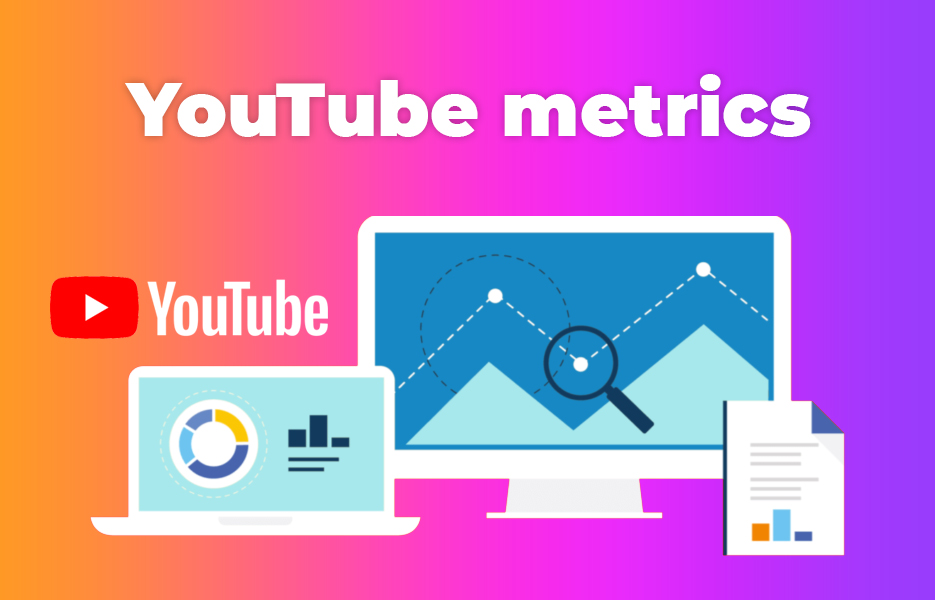
There are other key metrics that brands will want to know before you start working with them, and you’ll find them in the YouTube Analytics screen. It’s worth keeping track of this information, or having a template ready so it is easy to provide when potential brands approach you to create content for them.
The key metrics that you will want to keep track of are:
- Watch time
- Playlist engagement
- Average percentage viewed
- Unique viewers
- Average view duration
- Views per unique viewers
- Audience retention
- Demographics report
- Re-watches
- Subscriber growth
- Engagement
- Traffic sources
- Impressions click-through rate
- Keywords
- Card click-through rate
Although the higher each of these metrics are, the better, you shouldn’t necessarily make longer videos to keep your audience engaged. The YouTube algorithm favours quality content, and you only really have any influence over the click-through rate, watch time and how many videos a viewer has watched from your channel. Of course, you can’t directly control that, but working with demographic information, and looking at how other channels keep their audience hooked can be useful to know how to encourage viewers to subscribe and keep coming back.
Building your subscribers
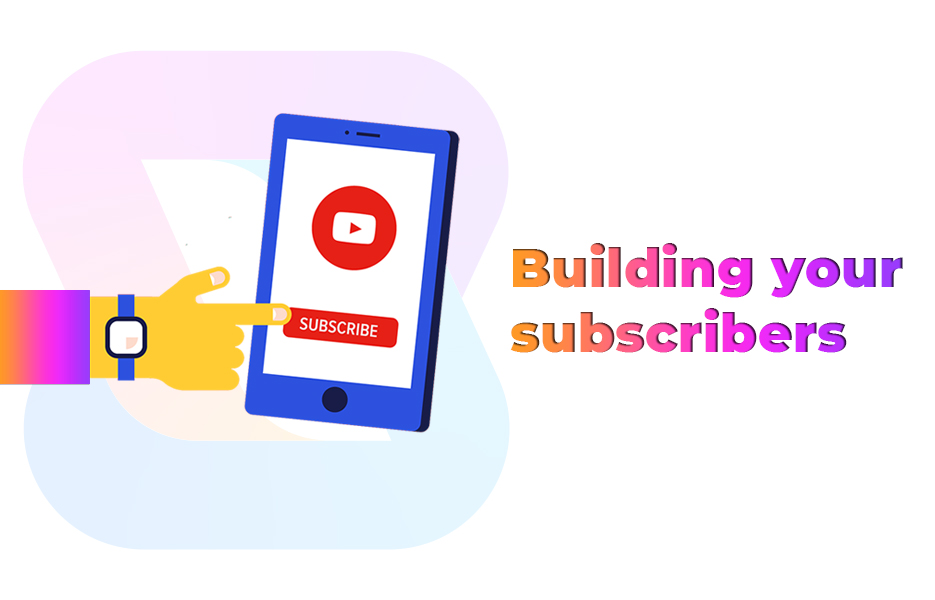
Although it would be nice to just upload your work to YouTube and be done, unfortunately you won’t make an awful lot of money if you’ve only got a handful of subscribers. Like we just mentioned, there’s a lot of demographic that brands will want to see before they decide to work with you. That means getting more subscribers, getting your watch time figures to be a lot more impressive, and so on.
If you’re still building your subscriber list (perhaps you’re following our guidance?) and trying to get the right number of watch hours, you’ll need to be posting quality content on a regular basis – one or two videos now and again won’t do it.
Be sure to get your branding right on YouTube. A brand aesthetic is essential to any business, and it’s the same on YouTube. There’s no reason not to get it right. Create your logo (if you don’t have one already!), get your channel description sorted, use keywords and add your other social media links – these will tell your audience that you are serious, and that your channel is something they want to work with.
Once you’ve optimised your branding on YouTube, you’ll need to think about how to optimise each video. Your content is likely to be great, so we’re talking about making sure your title is likely to draw views without being click-baity, using cards at appropriate moments to encourage click-throughs to other videos, using watermarks and so on.
When you have posted a few videos, you’ll want to set up playlists – especially if there are videos that follow on from each other logically. This will help increase your watch time, and means that viewers are more likely to watch more of your videos before clicking away.
We’re going to assume for the rest of this post that you have an account that has enough followers, or that you’re doing research for when you do have enough followers. Let’s start with
Sign up to be a YouTube partner
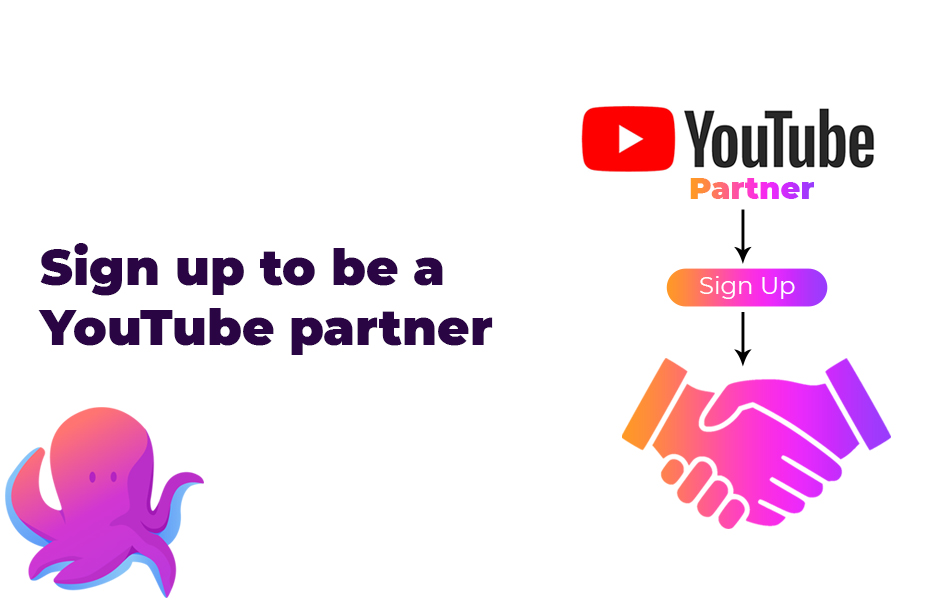
Nobody gets anything for free in this life, and it’s the same with your work online. When videos are uploaded to YouTube, you won’t earn money by default, and monetisation isn’t default either. You’ll need to enable monetisation in your account, and then you’ll be able to choose whether to join YouTube Partner Program, and work to encourage YouTube Premium sign ups.
YouTube Partner Program (YPP)
You don’t have to be a YouTube Partner to make money on YouTube, (if you’re getting views, you can just set up an AdSense account to start earning) but becoming a Partner will make it a lot easier to handle, and there’s plenty of other options that make joining the program worthwhile.
As a YouTube partner, you’ll be able to access more income streams, such as being able to use YouTube Premium subscription fees, and features like Super Chat and channel memberships. You’ll also get the opportunity to offer merchandise directly to your audience – we’ll get into how to create your merchandise later.
Applying for the YouTube Partner Program
The YouTube Partner Program requirements state that your channel must have reached 4,000 watch hours and 1,000 channel subscribers in the last 12 months. Before you apply, be sure to read the YouTube Community Guidelines. You’ll need to comply with them, and you’ll need to be careful to stick to the guidelines for your entire channel – not just individual videos.
To apply for the YouTube Partner Program, you’ll need to follow these steps.
- At the top-right of the YouTube homepage, click your account icon and select “Creator Studio.”
- On the left-hand side, click “Channel” and select “Status and features.”
- Under the box, “Monetization,” click “Enable.” Don’t be fooled if it says you’re already “Eligible” to the left; this just indicates there are no restrictions against you from trying to become a Partner.
- You’ll be asked to agree to the YPP Terms. Do so, and you’ll then sign up for an AdSense account so you can receive revenue through your monetized YouTube account.
- Set your ad hosting preferences and follow the prompts to submit your channel for review.
From there, you’ll need to go back to your dashboard. Go to the Analytics tab, and into Revenue. Scroll down to the Monthly Estimated Revenue, and you’ll discover how much you are likely to earn from your channel.
Usually, it takes about a week for your account to get enabled for the YouTube Partner Program. It’s worth doing though – YouTube splits ad revenue 55-45 with its partners — 45% to Google (remember, Google have owned YouTube since 2006!) and 55% to you.
How many ad views before you make money?
What you earn from YouTube ads on the Partner Program doesn’t match up to how many views your content gets. The criteria for advertisers states that viewers have to click an ad, or watch it entirely before you will get paid. There are other options for earning money from your YouTube posts though; so let’s carry on looking at alternatives.
YouTube Premium
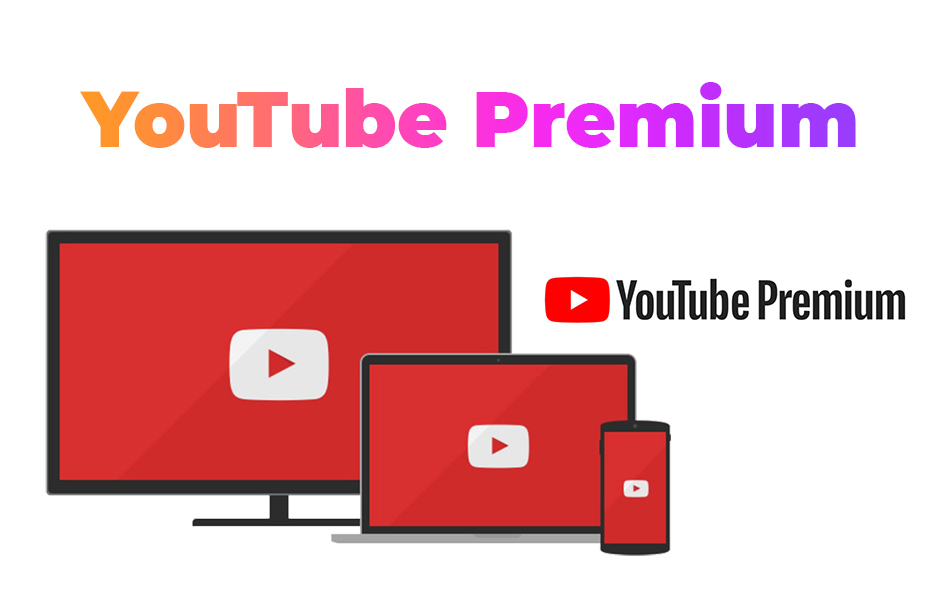
YouTube Premium is exactly what it sounds like – a paid subscription service that viewers can watch ad-free content. Like we said earlier, when you create content and upload it to YouTube, you don’t automatically get paid for it, because viewers are watching free of charge. YouTube make most of their revenue from advertising.
The minds at YouTube cottoned on to the success of paid-for content services, and listened to the feedback from users about how much they hated adverts – and so they created YouTube Premium to allow fans to watch without adverts. If you’re a YouTube content creator, and you’re signed up as a YouTube Partner, you can benefit from the money that YouTube Premium makes – you’ll simply get paid a percentage of YouTube Premium subscriptions.
Revenue from YouTube Premium membership fees is distributed to video creators based on how much members watch your content – so the higher your watch time, and the more of your videos are watched by Premium subscribers, the more you’ll earn from YouTube Premium.
You can earn money from YouTube Premium as well as being a YouTube Partner – so you will make money from both of these options. If you start to earn money from YouTube Premium, you’ll get paid it at the start of the month – at the same time you receive your ad revenue payments.
YouTube Premium benefits
Signing up for YouTube Premium involves paying a subscription. Once viewers have paid their subscription, they get to:
- Watch billions of hours of video on YouTube without seeing any ads.
- Download videos and playlists onto mobile devices to watch offline.
- Continue playing videos on mobile devices while using other apps, or when the screen is locked. (this is a major reason to sign up!)
- Access all the YouTube Original shows and movies.
- Get a free subscription to YouTube Music Premium – which means listening to music ad-free. (another major reason to sign up!)
- Enjoy music on Google Home or Chromecast Audio devices.
All these benefits are applied to YouTube, YouTube Kids and YouTube Music.
Encourage your viewers to become YouTube Premium subscribers
If your videos feature you talking – either on or off camera – you might try and boost your income by encouraging viewers to sign up for YouTube Premium. This is a bit of a gamble really, as it will only pay you if a viewer becomes a Premium subscriber and then continues to watch your channel. You be paid a cut of their subscription fee – but then, so will any other channel that they watch. Fans might sign up for Premium to watch your content without ads, but since they will then also have a bigger choice of ad-free content, the chances of your subscribers losing interest in your channel in favour of another also increase.
With that in mind, making money from YouTube means having several different streams of income will be valuable – so let’s look at some of the other options.
Are there any restrictions for what I can post on YouTube?
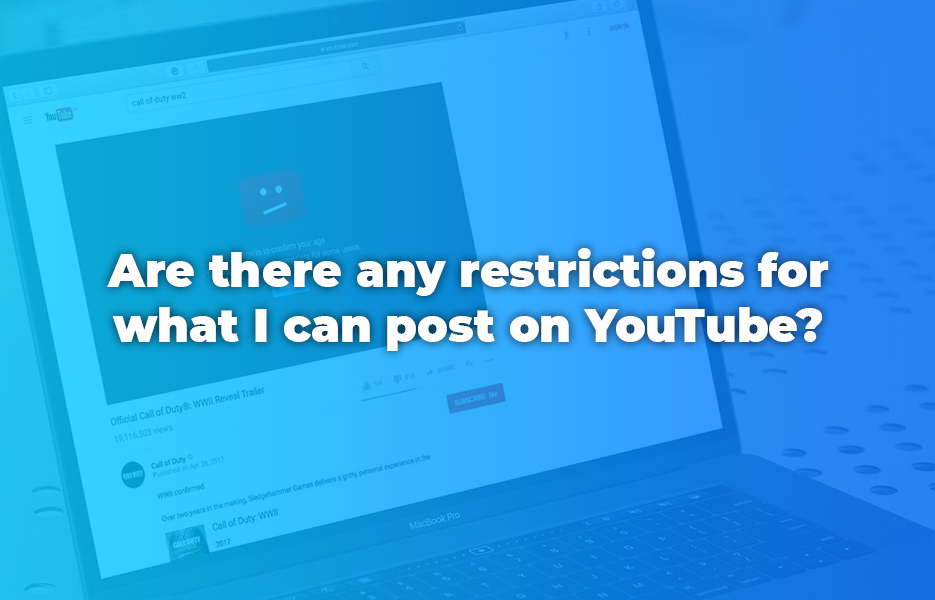
This is a really good question. You’ll need to be careful with what you post on YouTube, since if you break the YouTube Community Guidelines, you’re likely to get your content excluded from earning ad revenue. If you’ve worked hard to get to this point, you won’t want to lose it!
As with all social media platforms, there’s a whole bunch of guidance about what you shouldn’t post – which is pretty clear if you’ve read the YouTube Community Guidelines, as we suggested. However, some of the biggest issues that cause content creators to lose access to YouTube earnings include:
- Sexually suggestive content, including partial nudity and sexual humour
- Violence, including displays of serious injury and events related to violent extremism
- Inappropriate language, including harassment, profanity, and vulgar language
- Promotion of drugs and regulated substances, including selling, use, and abuse of such items
- Controversial or sensitive subjects and events, including subjects related to war, political conflicts, natural disasters, and tragedies. This counts even if you don’t show any graphic images
If your niche includes any of these – for example, if you’re always keen to nail a double entendre(!) – then you might need to look at other options that can help you make money from your YouTube content.
Create sponsored content
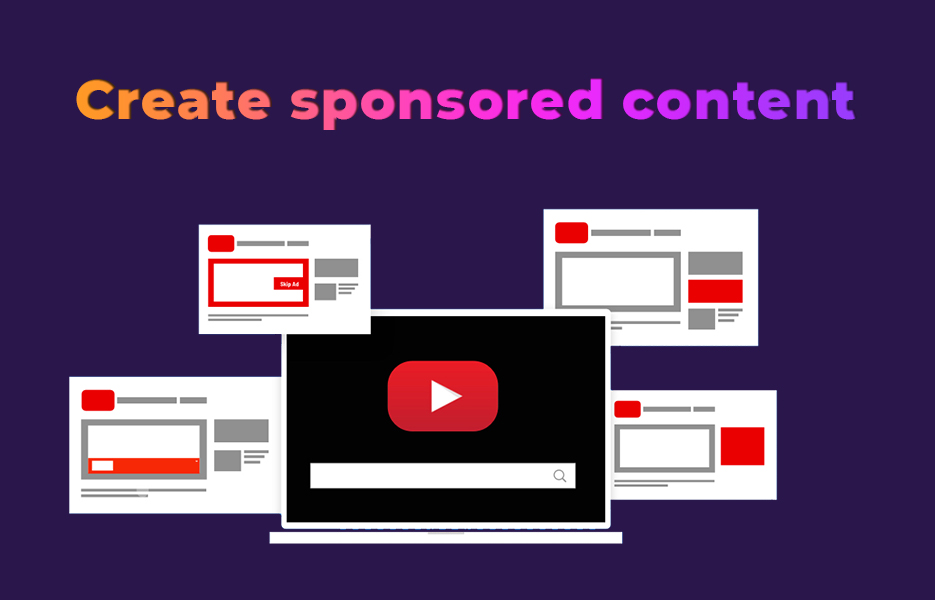
The influencer phenomenon is huge, and there are so many ways you can make money on your social media – we already looked at ways to make money on Instagram on the blog. Just like with Instagram and other social media platforms, you can create sponsored content for brands and post it on YouTube to earn money. With sponsored content on YouTube though, you’ll deal directly with the brand and you get paid directly from them, rather than waiting for YouTube to pay. This means that there’s no surprise that YouTube content creators love it. You’ll have much more artistic license to create what the brand wants – without worrying whether YouTube will penalise you for a smutty joke, for example.
If you’re looking to grow your sponsored content, there’s a few things you’ll need to do.
Finding a brand to work with is first on your list of priorities. You could just sit back and allow potential sponsors to find you organically – but with so much content being uploaded every single minute, potential sponsors are likely to never find you! You are up against a huge amount of competition, so look at finding an influencer marketing platform to sign up with. There’s a number available, so find one that facilitates the right connections.
When you’re signing up with an influencer platform, you might want to consider:
- The minimum number of subscribers the platform requires before you can sign up. Some platforms only require 1000 subscribers, others require 5000 or more.
- What sort of brands are using the platform? Is it likely that they are going to be a good fit for you? If there aren’t any brands that would work for you right now, look at alternative platforms.
- Can you partner with other YouTube content creators? Some platforms allow this as an option, and it can be well worth your while – especially if you are looking to increase your subscribers.
- While you’re still in the phase of having smaller numbers of subscribers, look for influencer platforms that allow you to receive money or products for completing tasks. These rewards might be small, but they can help you get to grips with the process.
Arrange your deal with your partner. You might arrange this through your influencer platform, but you might also need to communicate with the brand directly. YouTube videos are usually the most well paid content compared with other platforms, simply because production costs are significantly higher. Rates that brands are prepared to pay depend on your YouTube analytics – so like we said, have them ready, and know your worth!
Make it clear your sponsored content is advertising. Legally, in most countries you have to make it clear when you’re working with a brand and sharing this type of content. If you’re in the UK, you’ll need to be aware of the ASA guidelines, and if you’re in the US, you’ll need to be aware of the FTC guidelines. Outside of these countries, rules are different, so be sure to check – you don’t want to end up with a hefty fine.
Since you’re going to be effectively endorsing the brands you work with – and your content will be accessible essentially forever – it’s a lot better to work with brands that you actually like, and believe in. You’ll be able to tell your followers honestly about why you’re creating the content, and by working with brands you actually like, you’ll be able to do a much better job of creating content. This in turn, will lead to more chances of sponsorship opportunities and repeat collaborations.
Although you’ll be avoiding legal issues by making it clear your content is sponsored, it’s also good for your audience to know that they’re watching sponsored content. Most YouTube viewers are fully aware that there are sponsored posts, and advertising – and if they’re already subscribing to your channel, they are invested in your brand. Don’t treat your audience like idiots and pretend it isn’t happening! Apart from avoiding problems with the ASA or FTC, it’s better to be honest and authentic about your sponsored content – your audience will appreciate your honesty, and are more likely to continue to support you.
Being clear that your content is sponsored is pretty simple. Firstly, you can use the visible disclose feature when you’re publishing sponsored content on YouTube. This means your viewers will see ‘Includes paid promotion’ above the play button on your video. Can’t get much clearer than that, but you can also use hashtags in the video description to make it clear to your audience that your content is sponsored. Common hashtags include #ad, #spon and #sponcon. Finally, if it is appropriate, mention that the video is sponsored, either at the beginning, and end of your clips. If you’re going to mention it in your content, then you might thank your viewers for supporting the brands that you work with, as they enable you to keep producing the content they love.
Affiliate links
There aren’t usually many minimum requirements for affiliates, so it’s a good option for YouTube channels that do product reviews, how to guides and so on. Affiliate links on YouTube work the same way as other affiliate marketing campaigns – each time that company makes a sale from a link that you post on one of your videos, you get a payment.
You’re earning money from the company you’re working with, rather than from YouTube. To start earning affiliate commission, join an affiliate network. Each programme will offer different percentages per sale, and the more popular your channel, and your videos, the more you’re likely to be able to earn. You might be able to earn up to 75% commission on each sale – although lower rates are much more common.
Selling without being annoying
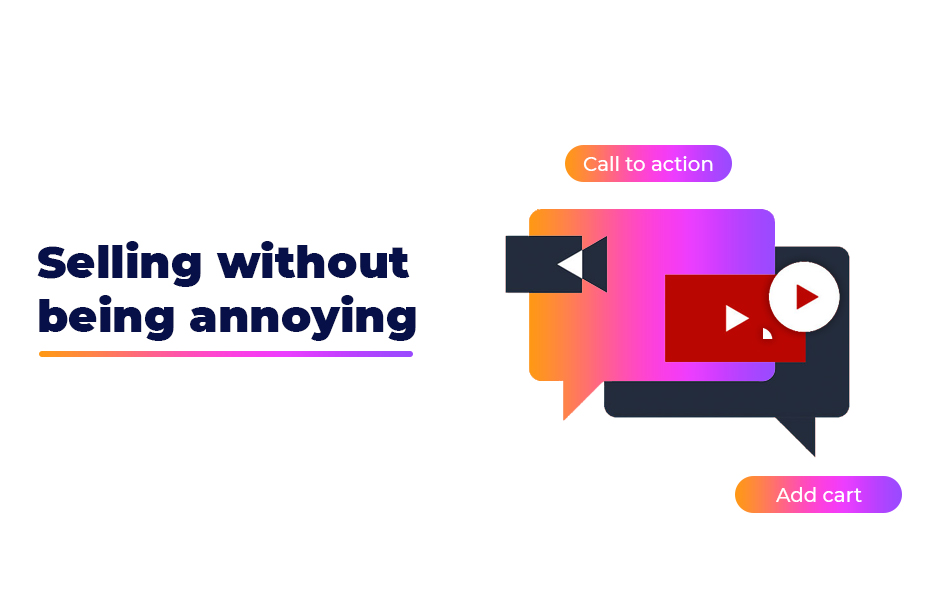
OK, so when you’re creating sponsored content, you’ll be selling either a product, a service, or you’ll be promoting a company. But one of the reasons that brands love working with influencers is because of their ability to create advertising content without it being like an advert. Unfortunately, we’ve watched videos – and stopped watching pretty quickly on way too many to remember – when it has been way too obvious that the creator was out to make a quick buck. However, we’ve also seen some really excellent authentic video content that happened to be sponsored. It’s really important to find the right balance in your content, so if you’re going to be successful in making money on YouTube, and to maintain that success, you’ll want to try and avoid that ‘sell, sell, sell’ mentality. So how do you sell, without being annoying? Well, there are several ways you can do this.
Add a call to action
You’re probably adding calls to action on your videos anyway – when you ask viewers to subscribe or to hit like, you’re using a call to action. If you’re being clear about the fact that you’re selling a product or a brand on their behalf, you can thank your followers for supporting your sponsored content, and that they can support you further by clicking through. There are many ways to prompt your audience to take action, so take a look at what other influencers are doing and see if you can come up with your own unique spin on it.
Check the terms of your sponsorship deal
Some brands are incredibly specific about what they will allow in your sponsored content. If you’re working with a brand that is much more rigid, you’ll need to be incredibly creative to avoid your content being just like that of every other influencer that they work with. We know some influencers actively avoid working with some brands because they’re not given enough leeway in what they’re allowed to do! If you’re lucky enough to work with a brand that is more relaxed about your content, great. You might be able to be more critical about the product or the brand (although bear in mind most brands will want to approve your work before they release payment) which means you can be more authentic.
Add cards to your YouTube videos
If you’re working with a brand and you think it’s likely that at a certain point your viewers are likely to be sold on a product, then add a YouTube Card to make it easy for them to click through. Many of your cards are likely to be most appropriate at the end of your videos – but you can experiment with adding them to other points in your videos too, and see where you get the most success.
Add links to your descriptions
Whatever you’re promoting – whether it’s a particular brand or product, or you’re promoting something for yourself, then make sure you add the relevant links to your video description. If you have been given an affiliate link to use by a brand, then be sure to add that to your description. The easier you make it for viewers to click through, the more chance that they will do it – which means more chance of money for you.
Cross promote your interests
When you’ve got more than just your YouTube channel on the go, you’ll need to make use of every tool you have. If you’re an influencer first and foremost, then you’ll still need accounts on other social media, to promote your YouTube channel. For example, you might use an Instagram account to promote your YouTube channel, and add behind the scenes photos, or use a Facebook Group to build a community and encourage discussion between like-minded individuals.
If you’re using YouTube to promote another business, then you’ll almost certainly have social media accounts to promote that. Whatever point you’re at, be sure to promote your sponsored content on your other social media accounts. You don’t have to post your sponsored content directly on your other social media – you can use it as a call to action (e.g. ‘new video… come and see on YouTube!’ will work just fine) but if you have affiliate links, you can also post those on your other channels too, for more chances of receiving money from your followers.
Crowd fund a project
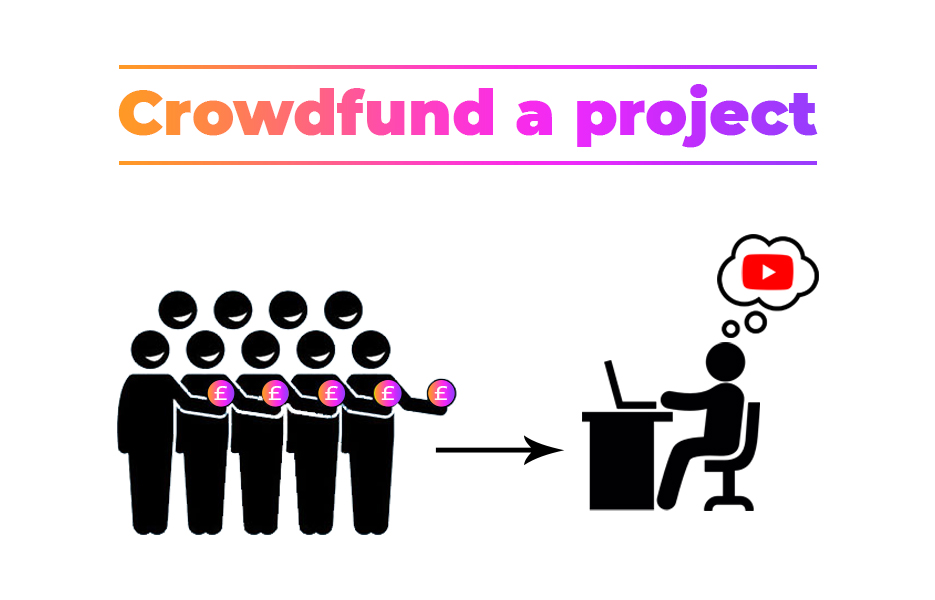
This isn’t necessarily a way to make money from YouTube exactly, but if you’ve got an amazing idea for a new video, or a series, then you might appeal to your fans to support you by contributing funds that help to pay towards it. Once you’ve got your idea, talk to your subscribers – either on your videos, on a live chat or on another social media – and ask whether your idea is something they would be interested in being brought to life. If you get a lot of positive feedback, you’ll need to establish how much your project will cost. Maybe you need to buy a certain piece of equipment, hire actors, or there’s other production costs that you’ll need to cover.
Work out how much you need in real terms, and then approach your audience with your proposal. Put together a video spelling out your plan for your project, asking your audience if they’d like to contribute. A great way to get fans excited is to create a trailer, or sneak peek. Remember, not everyone has access to loads of funds, so make it easy to contribute – every pound, dollar or euro that is contributed will add up. Don’t forget, you can also ask your audience to like and share your post if they’re excited about the project – which can help boost the chances of your post being seen and your fundraising efforts being successful quicker.
You can use crowdfunding websites like Patreon to handle your fundraising campaign, but there is a whole list of crowdfunding websites that are authorised by YouTube – so take your time to work out which one(s) are suitable for you.
Remember though, if you meet your crowdfunding target, you’ll need to set to work on your project as soon as possible. Your audience will want to see the project completed, so if it is going to take a while, be sure to post regular updates on your work. This will serve several purposes – it will keep your existing subscribers interested, and it’ll also encourage new viewers to subscribe for updates.
Receive direct payments from fans
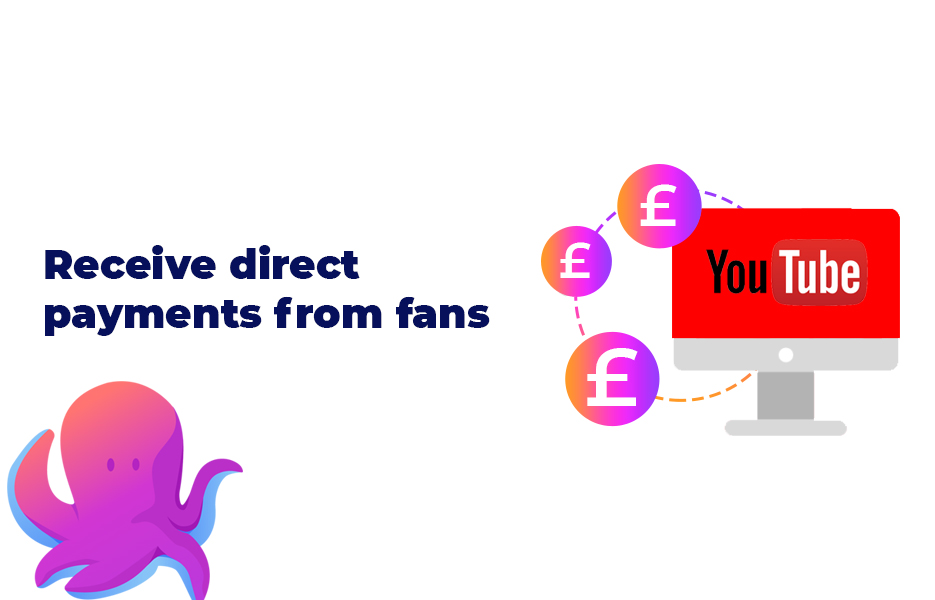
Asking for donations from your audience is pretty normal these days. Fan funding is a really popular way to get donations from your subscribers, and if your content is good then people might be happy to pay for it.
If you decide to go down this route, there’s a range of options you can try to receive payments. You might try to create a monthly income from your regular viewers, or you might look for one-off payments from your audience. Fan funding options include membership platform Patreon, which allows your subscribers to pay you monthly, and you can consider offering exclusive rewards to viewers who pay you through Patreon. If you want to allow subscribers to pay single payments as well as recurring payments, you might look for a payment platform like Tipeee.
If you’re using YouTube to promote your business offline or elsewhere on the internet, fan funding is less likely to be appropriate to you, but it is still worth a thought – especially if you’re building a cult brand as part of your business strategy. Think about offering incentives for people to make donations – if people think they’re getting something in return for a donation, they’re more likely to make that payment.
You can encourage payments on your YouTube videos through Super Chats – a feature than makes comments from viewers visible for a certain amount of time, depending on how much they pay. The more they pay, the longer their comment is highlighted and pinned in the live chat stream. This will go into your YouTube payments.
When you’re requesting payments from your fans, you’ll want to be clear about what you’re spending the money on. Just like crowdfunding, your audience will want to know what their hard-earned funds are going towards. If you’re sharing details of what you’re spending those donations on, your subscribers will be more invested in your content.
Offer channel membership
Another method of increasing your income can be to let subscribers pay to become members of your channel. You can offer custom emojis, members-only exclusive content, loyalty badges and Live Chats as options for rewards. If you’re offering paid channel memberships, you’ll need to thank your channel members in your videos, and be explicit about what the paid membership provides.
To increase the likelihood of people signing up for your channel and paying for it, you’ll want to consider if there is anything offline that you can offer as a perk. If you can offer priority access to a range of products, a sale or to an event that you’re holding, then that could sway more viewers to sign up. You can offer several levels of membership, though – with those who pay the most receiving more in the way of benefits.
License your content for use by the media
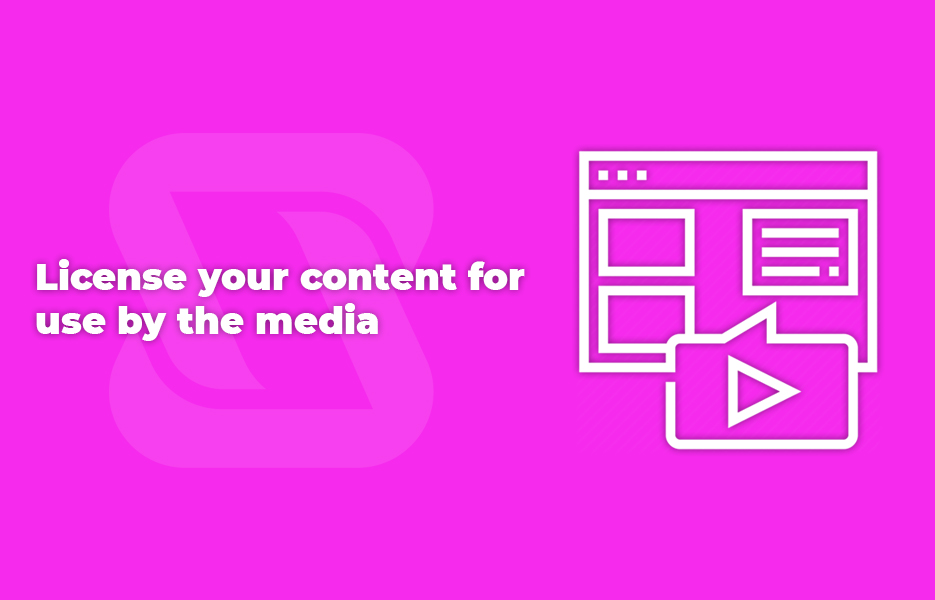
Many of the most successful videos end up being wanted by TV stations worldwide, for adding to ‘best of’ compilation shows, end of year roundups and so on. The news media also often need footage of an event, a natural disaster or anything else they might be reporting about – from sunny bank holiday weekends to new ships being launched to a famous person visiting a place they aren’t normally seen, such as a politician or a member of the royal family.
Mainstream media companies know they have to pay for the use of your content – which means just another way for you to be able to make money. Luckily, licensing your content for use by the media is really simple – there are just two simple steps.
The first thing you need to do is make sure your contact details are easy to find. Very simply, this just needs to be an email account for business enquiries. If you don’t want your email to be used by absolutely anyone and everyone, set up a separate account – it doesn’t need to be anything more than a regular Gmail or Outlook account. Check this account relatively regularly – you won’t want to miss an opportunity when it appears!
Secondly, you’ll need to register on a video rights marketplace. You don’t have to have a video that’s gone viral, or that has had millions of views. There are plenty of video rights marketplaces – just be sure to do your research before you get signed up so you know you’re on the right one.
How much money can you make from YouTube?
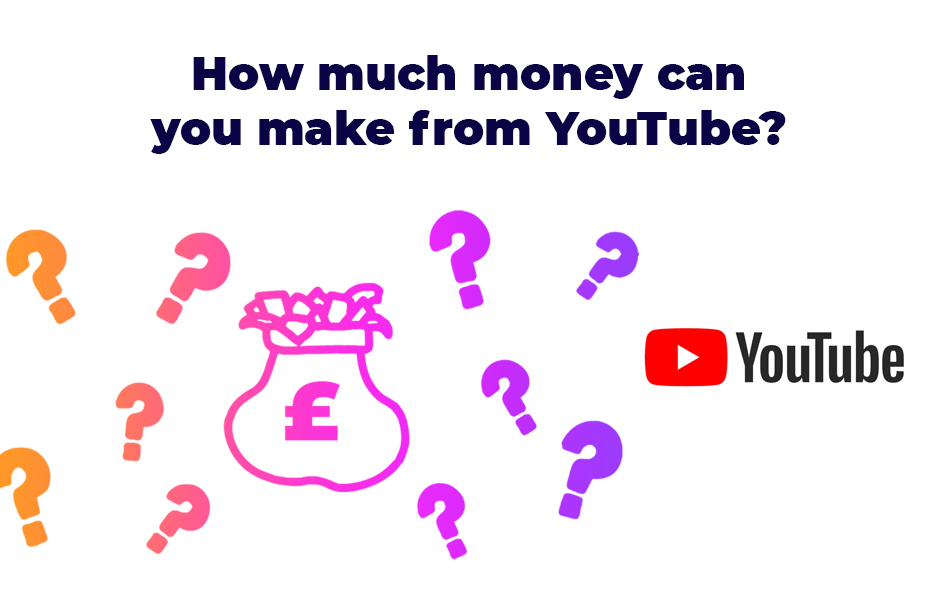
How much money you can realistically make from YouTube is dependent on a few factors. Your niche, your watch time, number of subscribers, and the demographic of your audience all contribute to how much you’ll be able to make, both directly from YouTube and from elsewhere.
YouTube is one of the highest paid platforms for influencers working with brand partners. When it comes to how much you’ll be able to make from sponsored videos, you can establish a baseline fee by taking the average number of views your videos, and multiply it by 5 to 15 cents per view. That’s the usual amount that brands offer on YouTube ads.
But it’s been shown that for more unique and profitable niche videos with higher audience figures – which are usually those with higher quality content – you might be able to negotiate more, especially if the brand deems that you’re a good fit to work with them. Because higher view figures are so important, some creators use systems to buy views to get their videos picked up by the algorithm quicker, and to make their view figures look good. There are legitimate systems that can do this, such as Viewsta – but make sure you do your research carefully before using other systems.
The richest YouTube creators
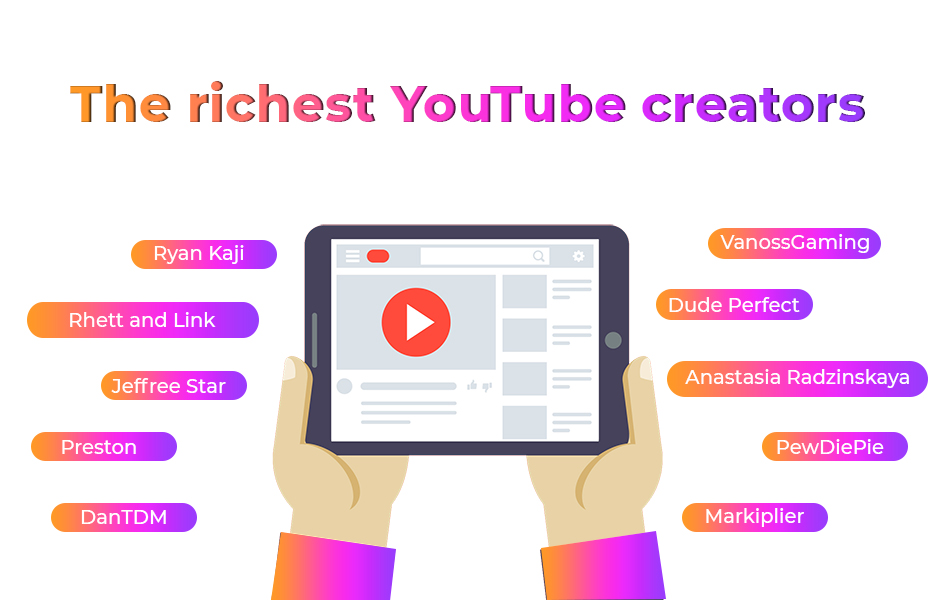
When you’re thinking about how to make money on YouTube, it’s a good idea to have a look at the top earners to see what they’re doing. You might be able to apply some of their strategy to yours!
The top 10 YouTube earners (as of the end of 2019) looks like this:
- Ryan Kaji – $26 million (toy reviews and kids science)
- Dude Perfect – (Coby Cotton, Cory Cotton, Garret Hilbert, Cody Jones and Tyler Toney) – $20 million (general entertainment)
- Anastasia Radzinskaya – $18 million (children’s entertainment)
- Rhett and Link – $17.5 million (entertainment)
- Jeffree Star – $17 million (beauty products/entertainment)
- Preston – $14 million (gaming/vlogger)
- PewDiePie – $13 million (gaming/vlogger)
- Markiplier – $13 million (gaming/comedy vlogger)
- DanTDM – $12 million (gaming)
- VanossGaming – $11.5 million (gaming)
When you’re looking at the top ten earners, it’s important to remember that they didn’t just make their fortune solely from their videos. They all have merchandise for sale, and other products that will help to diversify their income – just look at Ryan Kaji – he found fame initially through the videos he and his family were making doing toy reviews. But from that fame came an incredible line of merchandise, a show with Nickelodeon, toys licensed with his name, toothpaste and toothbrushes (yes really!). This makes it clear that although Ryan and his family might be earning millions each month, it’s not just from the videos they’re making (now under the brand ‘Ryan’s World’).
Diversifying your income stream is the key to your success – your YouTube videos should be just one strand of a wider strategy.
Diversifying your YouTube income
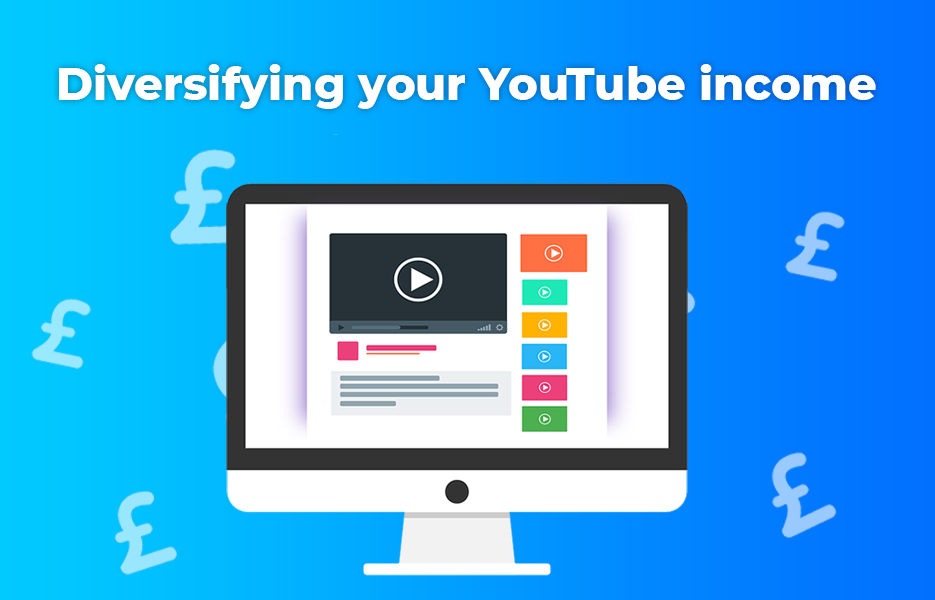
YouTube offers you a lot of potential to make money, but there are a lot of other people trying to do the same thing you are. With that in mind, if you’re trying to create enough income to quit your day job, then diversifying your income will get you there faster.
Use YouTube to sell products
If you’re thinking that you don’t have anything to sell, don’t worry – the products you are selling don’t have to be in your possession right now. By DropShipping on marketplaces and your own website, you can profit from selling products that you haven’t bought and paid for yet. Of course, this is a completely separate thing from selling on YouTube – but once you’re set up and selling, you can use your YouTube channel really effectively to increase awareness of your products, which in turn will make you more money.
It’s easy to start DropShipping, using a platform like Avasam. Finding suppliers of products that you think will appeal to your viewers and subscribers is straightforward, and with the best DropShipping platforms, you won’t have to pay for anything up front – subscription charges will be free until you’re making over a certain number of sales per month. Take a look at how easy it is by signing up for Avasam for free.
Creating your own merchandise
It’s easy to produce a range of merchandise for your most loyal fans using print on demand services. T-shirts, mugs, hats, artwork – if you have a huge following, fans will want to buy them, which can serve two purposes. Firstly, it’s an additional income stream, if you’re allowing subscribers buy from your channel or your website, or you can use them to promote your YouTube channel and increase your subscribers. Sell your merchandise on your website, send them to subscribers who donate over a certain amount to you, or use it for giveaway activities – we’re sure there are other reasons you might want to use your merchandise too!
You don’t even need to send your print on demand items out to your subscribers! Your print on demand supplier can take care of creating and dispatching orders from you directly to your customers. No trips to the Post Office required.
The only thing you will need to do is to create the designs. Whether you create the designs yourself, ask a friend or family member to help you out, or you work with a freelance graphic designer, it’s simple to create mock-ups for your print on demand items. By using mock-up generators, you won’t even need to order those items – although there are plenty of reasons to do so, like if you’re going to be using an item for a giveaway.
Making money on YouTube isn’t for the faint-of-heart. With the sheer amount of competition you’re facing – over 500 hours of video uploaded to YouTube every minute of every day – you’ll need to be producing the sort of high quality content that people want to watch. You’ll need to be collecting huge numbers of likes and subscribers, and the watch time for your channel needs to be as high as you can possibly get it – otherwise the amount of money you’ll be able to earn will be pretty small.
- Growing the numbers of subscribers you have on YouTube will increase the potential money you can earn.
- Use the YouTube Partner Program, create YouTube Premium content, and create sponsored or affiliate content for earning on YouTube.
- There are a number of strands to building your income from YouTube – use several to increase your earning potential.
- Use YouTube to promote products that you sell, and create your own merchandise for your audience.
If you’re looking for products to sell to your YouTube audience, you’ll find thousands of items on Avasam. You will only pay for the products that you sell once you’ve received payment from your customer, and there is no trial period – your Avasam account is simply free until you’ve sold more than ten items each month. Sound good? Of course it does. Sign up for your account here.
This post contains affiliate links. If you use these links to buy something, we may earn a commission. We only use referral links for businesses that we would use ourselves. Thanks for your support!

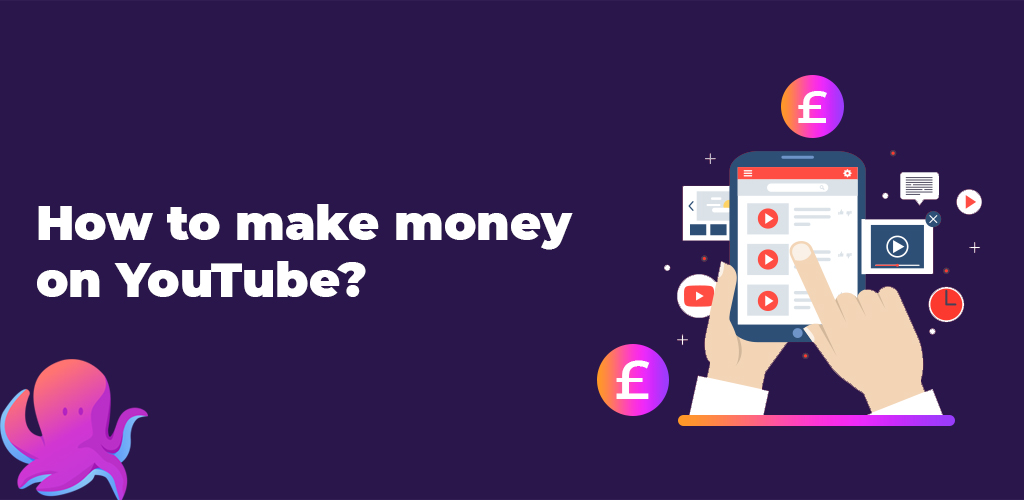


DropShip products from verified suppliers to diversify your inventory and scale your eCommerce business